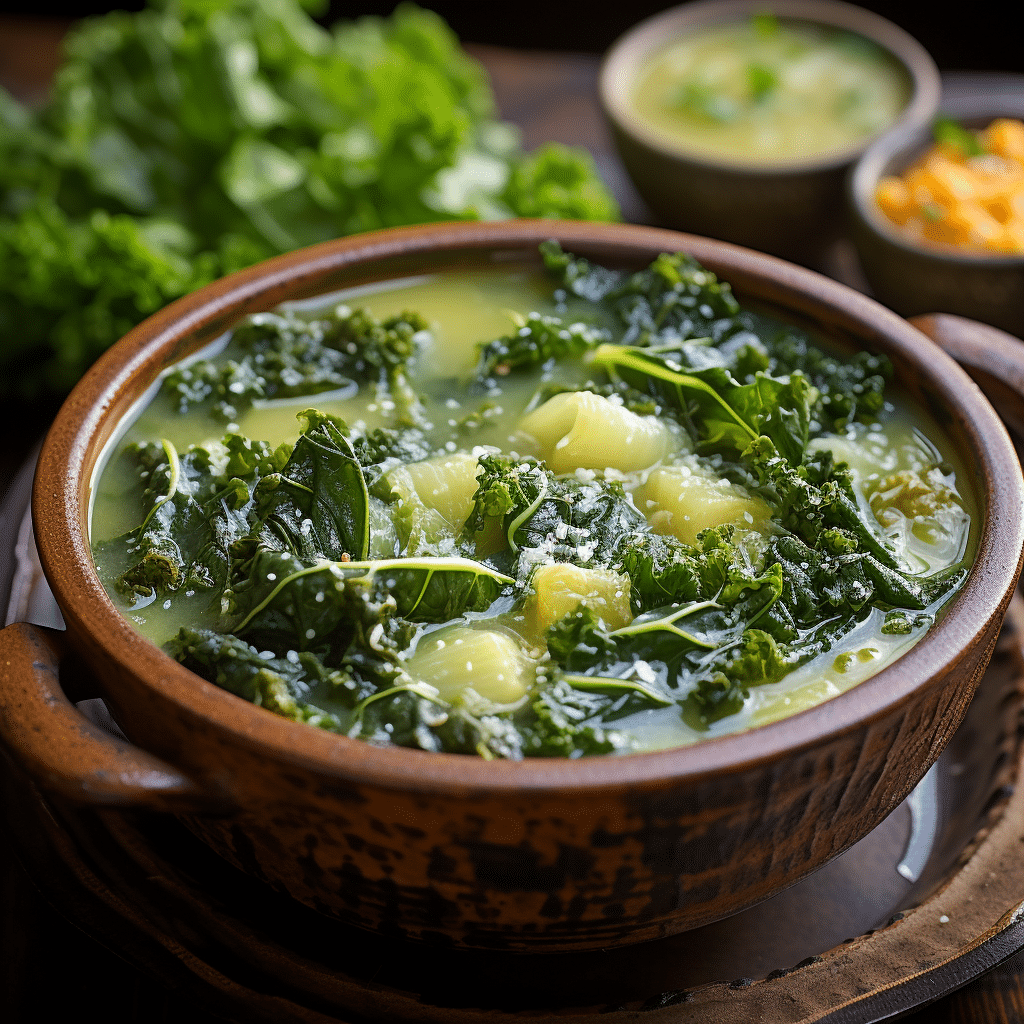Unlocking the Nutritional Power of Escarole Soup: The Unsung Superfood
When it comes to the world of leafy greens, the usual suspects garner the most attention – think spinach, kale, and broccoli. Now, let me introduce you to a lesser-known but no less nutritional counterpart: the escarole. It’s a versatile and nutritious vegetable that stars in one of the most wholesome dishes out there – escarole soup. So ladies, fasten your seatbelts. We’re about to delve into the world of this unsung superfood.
Escarole, a close relative of the chicory family, is a green giant. In its raw form, the escarole brings a satisfying crunch and a hint of sweetness to the palette. When you plunge these leafy greens into a pot of soup*, the heat transforms the mild sweetness into a pleasing bitter tinge that dances on the tip of your tongue.
Let’s take a minute to uncover the nutrient content of this leafy green. Packing a powerful punch, escarole is high in multiple B vitamins, including folate, as well as Niacinamide. These nutrients are renowned for preventing cardiovascular diseases, fighting colorectal cancer, and repairing skin proteins. It’s safe to say that a bowlful of escarole soup might as well be your secret weapon for health!
Escarole Soup: A Substantial Player in the Leafy Greens Category
Given the sheer number of leafy greens available on the market, it’s tempting to overlook escarole. But this would be a grave mistake! No pun intended, escarole soup is a literal pot of gold: a substantial player in the leafy greens category that you’d do well to include on your plate.
If you’re still not convinced, let’s put escarole head to head with the popular kids on the block. When lined up against spinach, kale, and broccoli, this undisputed heavyweight not only holds its own but also offers a unique taste profile that is both interesting and invigorating.
Compared to other alternatives such as curly endive, Belgian endive, bok choy, and even Napa cabbage, the escarole emerges as the champion. Its tough, dark green outer leaves offer a distinctive bitterness, making it a resourceful addition to your soups, stews, stir-fries or even wilted into pasta. The inner leaves possess a milder flavor and tender texture – perfect for that mixed green salad or sandwich you’re craving for lunch!

| Topic | Information |
|---|---|
| Description | A leafy green vegetable with a crunchy, bitter flavor that intensifies when cooked. |
| Uses in Dishes | Escarole is commonly used in soups (such as Italian Wedding Soup), stews, sautés, and pasta. It can also be used in salads and sandwiches. |
| Preparation Method | Start by wilting the escarole in hot oil with onions and garlic. Then, add broth, beans, parmesan rind, and bay leaves. Boil, reduce to a simmer, and mash some beans to thicken soup. |
| Taste | The inner leaves are mild, while the outer leaves have a pronounced bitterness which is released when cooked. The raw leaves can be slightly sweet. |
| Health Benefits | High in multiple B vitamins and Niacinamide. These nutrients help prevent cardiovascular disease and colorectal cancer, as well as assist in repairing skin proteins. |
| Substitutes | Curly endive, Belgian endive, bok choy, broad-leaved endive, Batavian endive, dandelion greens, Chinese cabbage, Napa cabbage, and turnip greens. |
| Popular Recipes | Traditional ingredient in Italian wedding soup, which combines escarole with round pasta and meatballs or sausage in chicken broth. Can also be found in stews, salads, and pastas. |
Reinventing the Traditional Escarole Soup Recipe: A Modern Take
Nothing beats a warm bowl of escarole soup on a chilly evening. But who says tradition can’t be tweaked? If you’re up for a culinary experiment, cooking a modern take on the classic escarole soup might just turn your kitchen into the next Food Network hotspot.
How about this: Start off with some hot oil, add minced garlic until fragrant. Next, throw in some onions, stirring until they soften. Add the escarole, toss gently until it begins to wilt, and then add stock and rice. Remember, the key here is alma–a pinch of soul. Cooking is spontaneous, and sometimes, a dash of the unexpected could bring about the most delightful surprises.
Want to thicken the soup? Here’s a chef’s little secret. Mash about a third of the beans in the pot–voilà, the perfect escarole soup! Pair it with fresh, crusty bread, and you’re in for a treat.
The Science behind The Health Benefits of Escarole Soup
Now that we’ve explored the culinary possibilities and pitted escarole against other greens, it’s time to understand the science behind its health benefits.
First and foremost, escarole soup is a considerable source of dietary fiber, thus promoting good bowel movements and reducing the risk of constipation. But that’s not all! The rich content of vitamins A and C means it’s high in antioxidants and immune-boosting compounds. According to a recent study, regular consumption of escarole soup could significantly lower the risk of developing chronic diseases, such as heart disease and cancer. Moreover, the soup could even help stave off osteoporosis in women.
But the benefits don’t stop there – escarole soup’s impressive nutritional profile also plays a critical role in weight management. The satiating fiber and protein content of escarole will keep you fuller for longer, preventing any erratic trips to the snack drawer.

Cultivating and Harvesting Your Own Escarole for the Perfect Soup
Despite its superfood status, escarole is not always readily available in grocery stores. But don’t despair! Growing your own escarole at home is not just viable, but also an incredibly rewarding experience.
You don’t need a green thumb to cultivate escarole. Escarole is a cool-season vegetable, so it’ll thrive in your garden even in light frost. Plant the escarole seeds about 1/4 inch deep into well-drained soil, spaced about a foot apart. In about a month, your garden will boast a glorious green carpet of escarole, ready to be harvested for the perfect soup.
And here’s a pro tip: harvest the outer leaves individually as they mature, leaving the center to continue growing. This way, you’ll enjoy a sustained supply of fresh escarole from your garden.
Bringing Escarole Soup to Everyday Menus: Pairing Ideas and Meal Plans
Integrating escarole soup into your daily menus is simpler than you might think. Pairing it with a wholesome lunch or dinner can transform your everyday meals into a culinary delight.
For a hearty lunch, pair a bowl of escarole soup with a grilled chicken sandwich on whole-grain bread. And for dinner, why not dive into a bowl of soup with a savory side of grilled salmon or turkey cutlets? For vegetarians, escarole soup goes beautifully with a warm quinoa salad or a platter of vibrant, Mediterranean-roasted vegetables. Don’t forget to check out these meal plans for an excellent blend of taste and nutrients.

A Bowl of Escarole Soup: Your Ticket to a Healthier Lifestyle
While a bowl of escarole soup may seem like a simple, humble meal, it represents so much more: a ticket to a healthier lifestyle. Regular consumption of this nutrient-dense soup can positively impact your physical fitness, mental health, and immune system, ensuring your wellness wheels keep turning as smoothly as ever.
Feeling sluggish during that mid-day work slump? An invigorating bowl of escarole soup could be just the pick-me-up you need. Besides, the rich antioxidants and vitamins will give your immune system a well-deserved boost, helping you keep those pesky colds at bay.
Rounding up with Reflections from the World of Health and Flavor
As we round up, let’s reflect on this pot of goodness. Escarole soup, with its remarkable health benefits and delicious flavor profile, is beyond doubt a powerhouse in the realm of leafy greens. So why not give this hearty, wholesome soup a chance to become your go-to health elixir?
Inevitably, trends in the food and health industry will keep evolving. But one thing’s for sure: escarole soup, with its timeless appeal and unparalleled nutritional profile, is here to stay. So, folks, it’s high time the spotlight shone on this unsung hero of the leafy green world!
Next time you plan your meals, remember the myriad benefits of this amazing soup. Take out your aprons and let your kitchen resonate with the wafting aroma of crisp escarole and the simmering goodness of the perfect escarole soup. It’s not just an adventurous culinary experience, but also your next step towards a healthier and happier life!
What is escarole soup made of?
Escarole soup is a classic concoction made primarily of escarole, a bright leafy green, combined with hearty vegetables like onions and carrots, garlic for that zing, white beans for protein, and smoky pancetta with chicken broth as a base to round off the soul-satisfying flavors.
What does escarole soup taste like?
Escarole soup sports a unique, slightly bitter taste that dances on your taste buds, contrasted by the smooth, mild flavors of the other ingredients in the soup. It’s savory, warming, and unarguably scrumptious — definitely a masterpiece in a bowl!
Can you put escarole in soup?
Absolutely! When you toss in escarole into soup, it yields an added depth of flavor that dances around like a jester, making it the life of the party in your soup pot. Soup is one of the best ways to enjoy this vitamin-packed veggie.
How do you use escarole?
Using escarole is a piece of cake! With its dynamic flavor and texture profile, it can be used in a variety of dishes. From stir-fries and salads to soups and stews, escarole fits perfectly every time.
Why is escarole so expensive?
Escarole tends to lean on the pricier side due to its marked-up demand and less widespread availability – it’s more of a specialty rather than a mainstream green. That’s economics for you!
What is the closest vegetable to escarole?
The closest vegetable to escarole would be radicchio. They share similar characteristics with a slightly bitter taste, though radicchio has a crunchier texture. It’s like a twin from another mother!
Is escarole anti inflammatory?
Yes, indeedy! Escarole boasts anti-inflammatory properties due to its high vitamin A and K content. It’s like nature’s own anti-inflammatory pill!
How do you cook escarole so it’s not bitter?
Cooking escarole so it’s not bitter is all about balance. Pair it with sweeter ingredients like onions, carrots, or even a drizzle of honey. Now, that’s how you turn that frown upside down!
What are the side effects of escarole?
Potential side effects of escarole could include an upset stomach or gas for some people. These effects tend to be mild and vary from person to person. It’s not always a bed of roses, huh?
How do you cut escarole for soup?
To cut escarole for soup, just chop off the stem, separate the leaves, rinse thoroughly to remove any grit, and then chop into bite-sized pieces. Easy peasy lemon squeezy!
Why is my escarole bitter?
Your escarole might be bitter due to its age or growing conditions. The older it gets, the more bitter it tends to become – like a grumpy old man!
Why is escarole good for you?
Escarole is good for you as it’s a powerhouse of essential nutrients like vitamins A, K, and C, as well as fiber. It’s almost like gulping down a health potion, really!
Do you eat the white part of escarole?
Indeed, you do eat the white part of escarole! It’s tender, crisp, and provides a sweet contrast to the slight bitterness of the darker leaves. Don’t let it go to waste!
What is another name for escarole?
Another name for escarole is “endive”. However, it’s all the same nutritious, leafy green — a rose by any other name, right?
Is cooked escarole healthy?
You bet! Cooked escarole is very healthy, offering a good dose of vitamins A, K, and C, as well as fiber and calcium. Could be the star of your next health-kick!
What kind of vegetable is escarole?
Escarole is a type of endive, a leafy green veggie within the same family as lettuce. Think of it as lettuce’s cool, hipster cousin!
Is escarole soup good for you?
Yes, indeed! Escarole soup is nourishing, hydrating, and packed with nutrients. It’s like a health spa in a cup!
What’s in escarole?
Escarole is packed with a variety of essential nutrients, including Vitamin A, K, and C, dietary fiber, calcium, and potassium. Quite the nutritional repertoire, wouldn’t you agree?
Is escarole a healthy vegetable?
Without a doubt, escarole is a healthy vegetable offering a rainbow of essential nutrients that contribute to overall health. It’s like a superhero in disguise on your dinner plate!






























